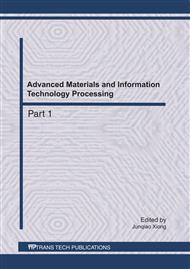[1]
A. An, C. Chan, N. Shan, N. Cercone, W. Ziarkom: Applying knowledge discovery to predict water-supply consumption, Expert IEEE, Volume 12, No. 4, pp.72-78, (1997).
DOI: 10.1109/64.608199
Google Scholar
[2]
A. E. Hassanien: Rough set approach for attribute reduction and rule generation: a case of patients with suspected breast cancer, Journal of the American Society for Information Science and Technology, Volume 55, No. 11, pp.54-62, (2004).
DOI: 10.1002/asi.20042
Google Scholar
[3]
J. L. Breault: Data mining diabetic databases: are rough sets a useful addition?, Proceedings of the 33rd Symposium on the Interface, Computing Science and Statistics, Costa Mesa (CA): The Interface Foundation of North America, in press, (2011).
Google Scholar
[4]
Wang Guoyin: Rough set theory and knowledge acquisition[M]. Xi'an:Xi'an Jiaotong University Press, (2001).
Google Scholar
[5]
Liu Jing, Wang Guoying, Hu Feng: Cut's discriminability based continuous attributes discretization in rough set, Journal of Chongqing University of Posts and Telecommunications, Volume 22, No. 2, pp.257-261, (2010).
Google Scholar
[6]
Wang Xizhao, Zhao Suyun, Wang Jinghong: Simplification of information table with fuzzy-valued attributes based on rough sets, Journal of Computer Research and Development, Volume 41, No. 11, pp.1974-1981, (2004).
Google Scholar
[7]
Xie Hong, Cheng Haozhong, Niu Xiaodong: Discretization of continuous attributes in rough set theory based on information entropy, Chinese Journal of Computers, Volume 28, No. 9, pp.1570-1574, (2005).
Google Scholar
[8]
Li Xingsheng, Li Deyi: A new method based on density clustering for discretization of continuous attributes, Journal of System Simulation, Volume 15, No. 6, pp.804-806, (2003).
Google Scholar
[9]
Zhao Jun, Zhou Yinghua: New heuristic method for data discretization based on rough set theory, Institute of Computer Science and Technology, Volume 16, No. 6, pp.113-120, (2009).
Google Scholar
[10]
Amitava Roy, Sankar K. Pal: Fuzzy discretization of feature space for a rough set classifier, Pattern Recognition letters, Volume 24, No. 6, pp.895-902, (2003).
DOI: 10.1016/s0167-8655(02)00201-5
Google Scholar
[11]
Yang shu zi, Ding Hong, Shi Tieling: Diangosis Reasoning Based on Knowledge[M]. Beijing: Tsinghua University Press, (1993).
Google Scholar


